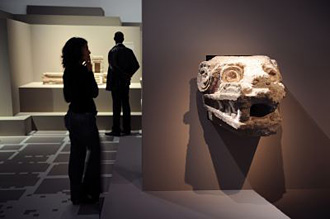Mexico's Mystery City of Gods, Teotihuacan, Goes to Paris
 Agence France-Presse Agence France-Presse
go to original
October 07, 2009


| | (AFP/Fred Dufour) |  |
Feathered serpents and sacred jaguars from ancient Mexico's mysterious City of Gods, Teotihuacan, show in Europe for the first time at an unparalleled exhibition opening in Paris.

"It's the biggest exhibition ever on Teotihuacan", Miguel Baez, of the National Institute of Anthropology and History (INAH), told AFP. "We in Mexico love shows from other places, this time we aim to display our great civilisation."

Some 450 pre-Columbian pieces, some of them monumental, some rarely or never exhibited, are on show until next January 24 in the French capital's newest arthouse, the Quai Branly museum, under the title "Teotihuacan, City of the Gods".

A fearsome oversized 1,500-year-old jaguar recently discovered at the giant site opens the exhibit, also featuring new proof of rampant human sacrifice.

One such item, which reverses previous thinking that Teotihuacan was a peaceful society, is a large just-excavated marble statue of a slave showing signs of bondage and arrows in his limbs.

Wrapped in thick vegetation when rediscovered in the 19th century, little is yet known about the giant ancient city of Teotihuacan, which became a regional powerhouse in its 800-year history until its mysterious fall around 700 AD.

At its height, the city built in semi-arid highlands barely 50 kilometres from Mexico City was home to more than 200,000 people, bigger than any European city of the time.

"We don't know who built it, how it was governed, or what happened to cause it to collapse," said Baez.

"We have more questions than we have answers."

Though one of the world's larger archeological digs, less than 10 percent of the 22-square-kilometre site has yet been excavated, leaving experts puzzling over why it disappeared -- internal strife, invasion, disease, or hunger caused from over-intensive use of the land?

"Teotihuacan was not even its original name," Baez said. "We still don't know its name."

Discovered by Aztecs several centuries after being mysteriously abandoned and left crumbling, the Aztecs were so impressed by its greatness and beauty that they called it "the place where Gods are born" -- in Nahuatl, Teotihuacan.

The city was laid out according to a cosmic view, with a main road, the Avenue of the Dead, running straight towards the mythical Pyramid of the Moon. Close by lay the Temple of the Feathered Serpent and the Pyramid of the Sun.

"Earlier than Rome and over a very long time they rigorously built a massive city on a grid," said Brendan MacFarlane, the New Zealander scenographer who worked with France's Dominique Jakob to recreate a giant model of the city at the show.

People lived in some 2,000 residential complexes grouping anywhere between 20 to 100 people, with family apartments organised around a central patio. Items on show were found in 15 of the complexes.

And while archeologists have found trace of the artists and know there were priests and traders and slaves, nothing is known of the system of governance or the rulers.

"There was no sense of personal identity, none of the statues are made in anyone's likeness," said Fabienne de Pierrebourg, who is in charge of the French museum's Americas collections.

"It is the most mysterious civilisation of the continent," she added.

The exhibition is to travel to Zurich and Berlin. Details on www.quaibranly.fr |



